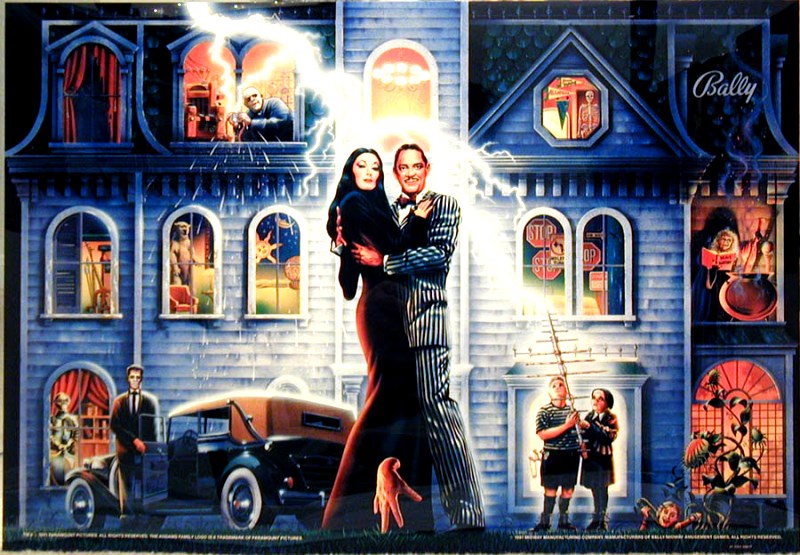Highway to the Danger Zone
by 2nd Place Andy
[two_third last=”no” class=”” id=””]My strategy for the Addams Family is quite narrow. Many of the shots and features of the game can be ignored. This is helpful, however, because there are fewer situations to practice or memorize. Instead, I just focus on keeping control of the ball in each of the game’s three Danger Zones.
You will repeatedly have to deal with these Danger Zones, so master them and you will exponentially improve your score.
The first Danger Zone is the Graveyard exit shot from the mini Thing flipper. This is generally accessed from the left ramp (or Bear Kicks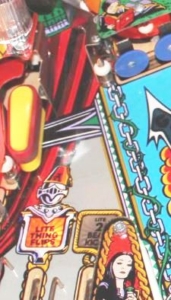 during the Seance). It is tempting to shoot across to the Swamp for 5x value. However, safely feeding the left flipper is more desirable. A slight nudge here can keep the ball away from the left outlane. Try nudging right just as the ball passes by the mini flipper to guide it into the 2 Bear Kicks lane. With practice, both the Electric Chair and Bear Kick Ramp can be shot safely as the ball rolls down the left inlane. Take note that if you activate Thing Flips from the Bear Kick ramp, the mini flipper will always engage, making it impossible to feed your left flipper.
during the Seance). It is tempting to shoot across to the Swamp for 5x value. However, safely feeding the left flipper is more desirable. A slight nudge here can keep the ball away from the left outlane. Try nudging right just as the ball passes by the mini flipper to guide it into the 2 Bear Kicks lane. With practice, both the Electric Chair and Bear Kick Ramp can be shot safely as the ball rolls down the left inlane. Take note that if you activate Thing Flips from the Bear Kick ramp, the mini flipper will always engage, making it impossible to feed your left flipper.
The second Danger Zone are the kickouts- Electric Chair (left) and Swamp (right). Right before a ball kicks out, the game warns players 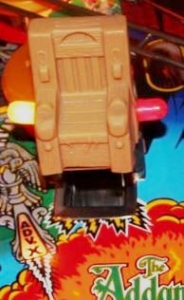 with a thunderclap sound and a flashing lightning bolt. The lightning will flash on the same side as the kickout! Hopefully, the kickouts follow the same trajectory every time. However, be prepared to adjust your strategy to compensate for machines with less consistent kickouts.
with a thunderclap sound and a flashing lightning bolt. The lightning will flash on the same side as the kickout! Hopefully, the kickouts follow the same trajectory every time. However, be prepared to adjust your strategy to compensate for machines with less consistent kickouts.
Let’s look at all the different options for stopping the ball after it comes out. You can find descriptions (and often videos) of these maneuvers online (www.ipdb.org) if you are unfamiliar. From easiest to hardest to perform: Hold Trap (I call this “hold and pray”); Dead 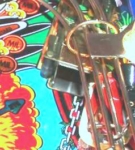 Pass; Flip Trap / Live Catch; Drop Catch; Reflex Flip (flipping the ball right as it comes to the flipper). Unless you have incredible, repeatable accuracy with this last method, I do not recommend it. However, most novice players play exclusively this way. On an ideal machine, Hold Traps and Dead Passes work 100% of the time from both kickouts. Usually a Dead Pass works on at least one side. Once you have the ball safely trapped in the cradle, you may attempt a post-pass (if possible) before shooting the next shot.
Pass; Flip Trap / Live Catch; Drop Catch; Reflex Flip (flipping the ball right as it comes to the flipper). Unless you have incredible, repeatable accuracy with this last method, I do not recommend it. However, most novice players play exclusively this way. On an ideal machine, Hold Traps and Dead Passes work 100% of the time from both kickouts. Usually a Dead Pass works on at least one side. Once you have the ball safely trapped in the cradle, you may attempt a post-pass (if possible) before shooting the next shot.
The third Danger Zone is the right inlane (such as after shooting the Bear Kick ramp).
Controlling a rolling ball is difficult! Try out: Hold Trap; Hold and Tap (flip the flipper hard right before the ball gets there, and it may stop 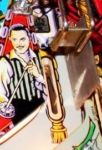 entirely – usually more effective with a small nudge); Inlane Pass / Bop Over / Tap Pass; Inlane Loop Pass; Rolling (Live) Post-Pass; Reflex Flip (careful!); Half Volley (For games where the ball does not have enough momentum to complete a rolling pass, hold the flipper up, then release just after the ball touches the flipper, then quickly strike the ball again. This propels the ball much slower than a reflex flip, yielding a safer ricochet on missed shots); Alley Pass (“Shatzing the inlane”). I must emphasize that dialing in your Reflex Flip seems like the simplest option here, but it is also the most likely to drain. So try out everything else and see what’s the most consistent!
entirely – usually more effective with a small nudge); Inlane Pass / Bop Over / Tap Pass; Inlane Loop Pass; Rolling (Live) Post-Pass; Reflex Flip (careful!); Half Volley (For games where the ball does not have enough momentum to complete a rolling pass, hold the flipper up, then release just after the ball touches the flipper, then quickly strike the ball again. This propels the ball much slower than a reflex flip, yielding a safer ricochet on missed shots); Alley Pass (“Shatzing the inlane”). I must emphasize that dialing in your Reflex Flip seems like the simplest option here, but it is also the most likely to drain. So try out everything else and see what’s the most consistent!
Try all the options! Figure out what works for you. See if you can perform a move 10 times in a row. Experiment, assess, adjust. The idea here is to navigate each Danger Zone perfectly every time. Then follow the flowchart for massive points. Good luck!
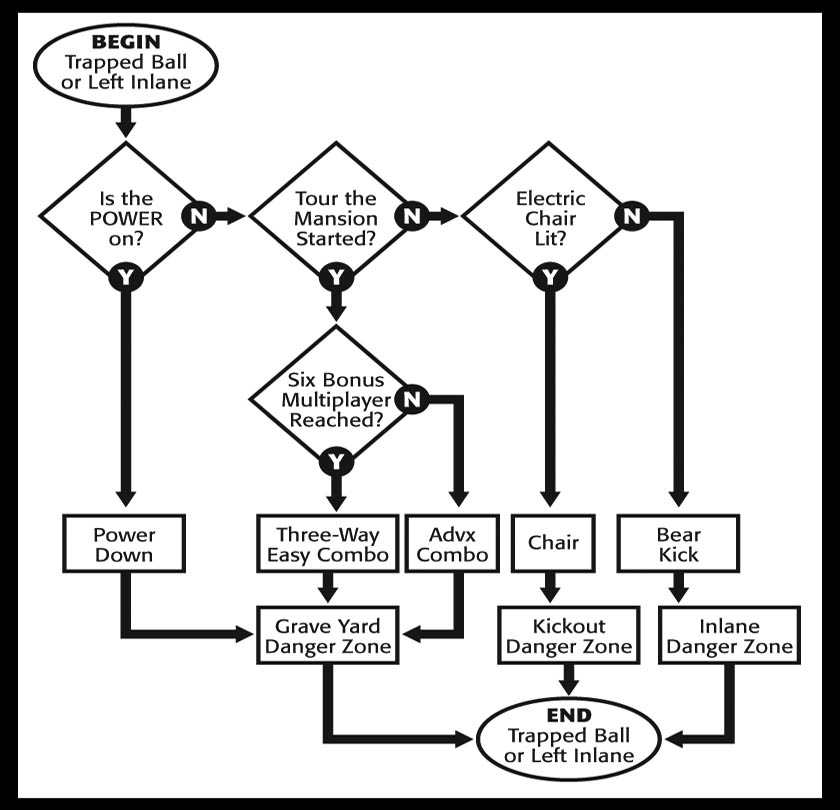 Originally published in Skill Shot 44[/two_third]
Originally published in Skill Shot 44[/two_third]
[one_third last=”yes” class=”” id=””]
Side Bar Glossary
By Kayla Greet
Hold Trap – Just as simple as keeping your flipper up to trap the ball as it rolls through the inlane or out the kickout.
Hold and Tap (sometimes called Flip Trap) – Similar to above, keep your flipper up to trap, but if there is considerable speed on the ball, give the machine a nudge or tap the flipper to dampen the velocity.
Dead Pass / Dead Flip – One of the easiest moves because it involves doing nothing at all! Keep your flipper down, let the ball bounce off the rubber and arc over to the other flipper.
Live Catch – When the ball hits your flipper, engage it to meet the ball exactly when the flipper is fully extended. This halts the ball, makes it look as if it is stuck on the flipper, and will allow you to trap it.
Drop Catch – Much like the Live Catch, you’re essentially ‘bunting’ the ball. Pull the flipper back just as the ball makes contact. This mutes the energy of the ball and then you can re-engage the flipper to trap.
Reflex Flip – “See ball, Hit ball.” Nothing fancy.
Post Pass – Start with a trapped ball. Then take the trapper flipper and give the button a half tap, which sends just enough kinetic energy to arc the ball to the other flipper, often but not always ricocheting off the above slingshot post.
Inlane Pass – This motion often involves a feed to the flippers from a ramp shot, like the Bear Kick on TAF. Hold your flipper up like a mini ramp and allow the ball to pop over to the other flipper. Sometimes it requires a bump or nudge to the front of the machine for a little extra oomph.
Bop Over – Same as Inlane Pass but with a fluttering “flick” of the flipper to give the ball extra momentum.
Flick Pass / Tap Pass – Let the ball roll to the end of the flipper and give it a tiny tap (so tiny in fact that the flipper will not appear to move) to transfer it to the other flipper. Usually works best on electromechanical (EM) games.
Inlane Loop Pass – Starts as an Inlane Pass but drop the flipper as soon as the ball makes contact. Works well on games with high speed inlanes.
Rolling Post Pass – Same as the Post Pass but with the ball in motion instead of a trap.
Alley Pass / Shatzing the Inlane – This move, made famous by California player Neil Shatz, involves the ball in a trap on a flipper and tapping the button just enough to get the ball to travel back up the inlane rollover. Great way to take advantage of a lit inlane to qualify its award, such as an Extra Ball.[/one_third]

